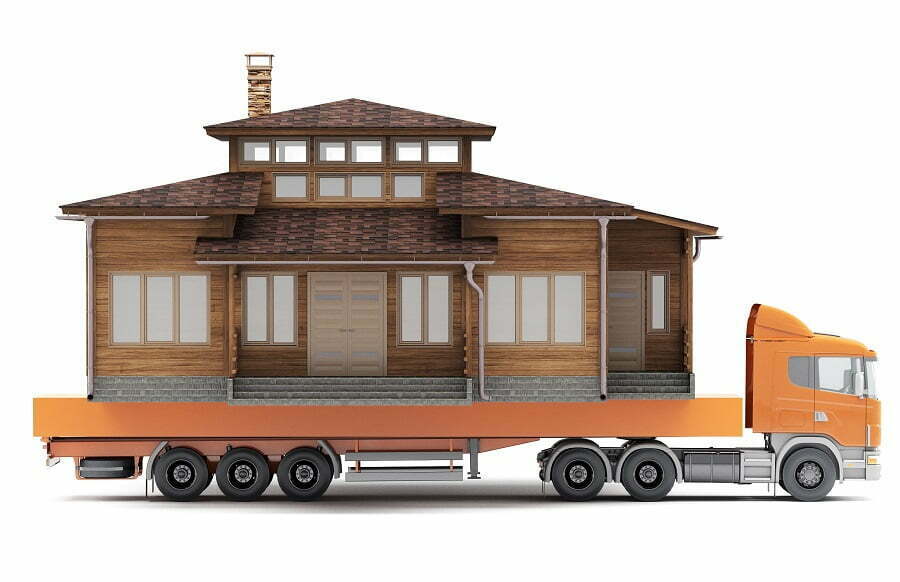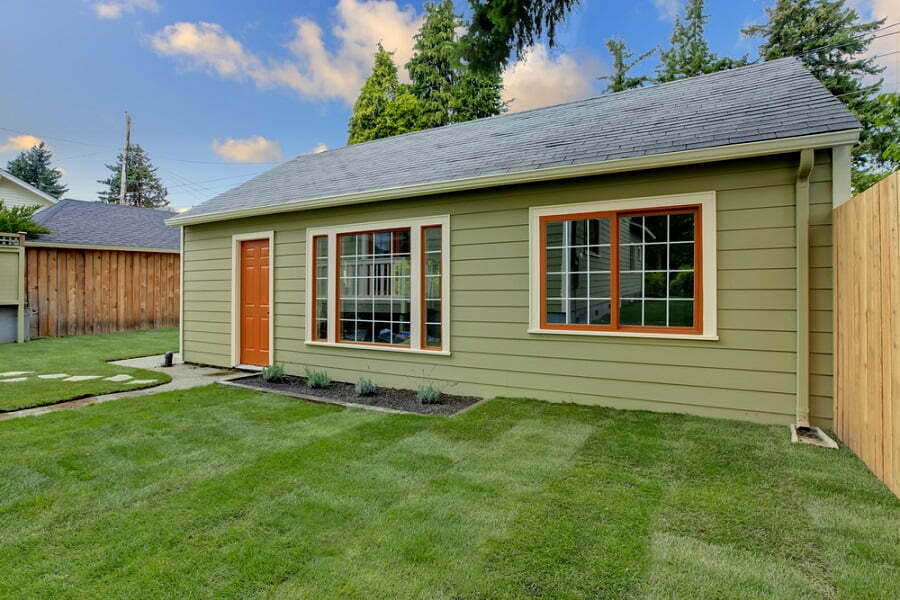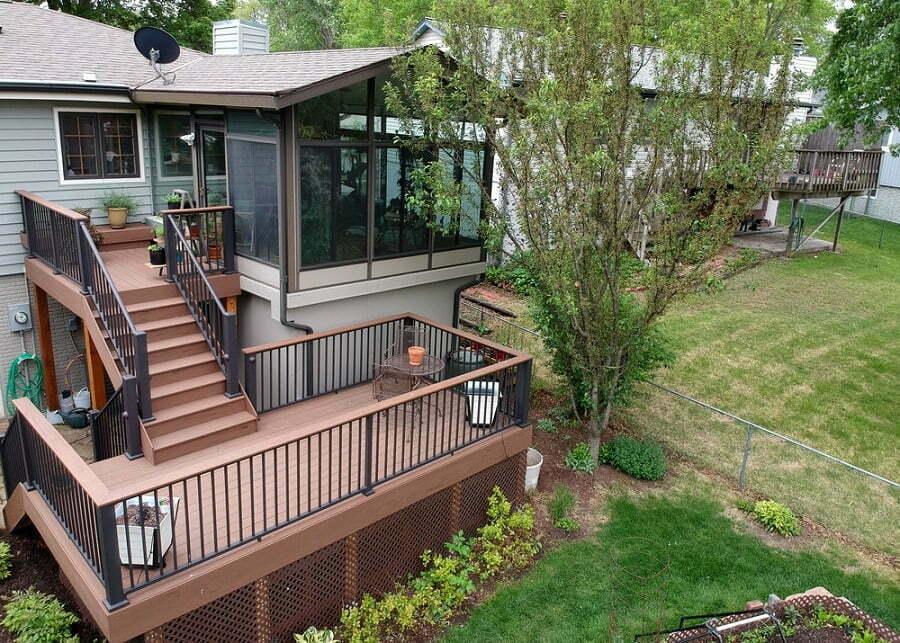Last updated on
Moving a prefab home is not simple if it’s not mobile. It means disassembling it and rebuilding it on a new site. Here’s how.
If the prefab is modular, it helps the case a bit. Modules are easier to disconnect and move to a new location. Meanwhile, prefabs that are built on permanent foundations take effort and time to move.
We will look at these differences in moving prefabs of different types, the caveats, and the costs. While it is difficult, it is doable.
What’s needed to move a prefab in general:
- A truck (or trucks) big enough to fit the modules and prefab parts in.
- Equipment and tools to dissassemble the prefab.
- Equipment to get the modules to the truck.
- Equipment to help lower the house down to ground level.
- Equipment to bring them to their final destination.
- Tools for moving and re-assembling the modules.
Moving a Prefab Home Built on Foundation

Most prefab homes, unless they are mobile, are built on a foundation. This foundation will need to be rebuilt on the new site. Due to the nature of being built into the ground, the foundation cannot be moved.
A modular home has three different types of foundations. There is the base slab which is located at the bottom of the house. Then there is the footer slab which sits under the base slab. And finally, there is the sill plate which goes underneath the footer slab.
A modular home is designed so that the slabs are stacked on top of one another like layers of an onion. Each layer is connected to its neighbors using these metal connectors.
When the house is first placed on the site, the slabs are lifted onto the foundation forms. Once the forms are removed, the slabs are lowered into place.
Most prefab homes have two foundations: one for the main structure and one for the basement.
There are several reasons why prefab homes have multiple foundations. One reason is that the main structure needs to be strong enough to support the roof. Another reason is that the basement requires additional reinforcement.
The main structure is stronger than the basement because it supports the weight of the entire house. The basement is only used as storage space and doesn’t require much structural strength.
The basement foundation is typically smaller than the principal structure foundation. This is because most basements don’t have crawl spaces. So the basement foundation only needs to hold up the floor joists.
Prefabricated houses are built in factory environments where they’re tested for quality before being shipped to their final destination. They’re then placed on foundations made. They’re usually delivered to the site already assembled and ready to go. When moving, all of this will need to be rebuilt.
Prefab House Preparation for Moving
Before you begin moving your house, you’ll want to prepare both the interior and exterior of the house.
Here are some things that you should do:
- Remove all furniture and belongings. You should remove everything inside the house before you begin moving the house.
- Clean the house. You should clean the entire house prior to moving it.
- Disconnect power. You should disconnect the electricity before you begin moving the house.
- Prepare the driveway. You should clear out the driveway of any obstacles that could cause damage to the house when it’s being moved.
- Locate the utilities. You should locate the utilities in advance so that they aren’t damaged while the house is being moved.
- Mark the floor plan. You should mark the floor plan of the house so that you can easily find your way around the house after it has been re-installed.
Site Preparation for Moving
To ensure that the house doesn’t collapse during the move, you’ll want to prepare the site where the house will be placed.
- Dig holes for the foundation. You should dig holes for the foundation of the house before you begin installing the house.
- Level the ground. You should level the ground so that the house sits flat on the ground.
- Place stakes. You should place stakes along the perimeter of the house so that you can accurately measure the size of the house once it’s installed.
- Measure the length of the house. You should measure the length of the house so that you can determine how much space you’ll need.
- Build the foundation. If you’re prefab home was built on a foundation, you will need to recreate this at the new site.
Detaching Utilities Before Moving
When you’re planning to move a prefabricated house, you’ll want to make sure that you detach the utilities first.
This will prevent any accidents from occurring during the move.
- Turn off and disconnect the gas. You should turn off the gas before you begin moving the house.
- Shut off the water supply and disconnect the plumbing. You should shut off the water supply before you begin moving the house.
- Disconnect the electric wiring.
These will need to be done by a professional to complete the tasks safely. Don’t try to do this yourself unless you have experience in this.
Moving Your Modular Home
Now that you know what needs to be done before you start moving your prefabricated house, let’s look at how to move it.
The most important thing to remember about moving a prefabricated house is to keep the house level throughout the process.
Then, moving the prefab depends on the type of manufacturing. Here’s what you need to know about moving the three main types of prefabs.
Relocating a Mobile Home
They are mobile, so they can move from place to place quickly if necessary, making them ideal for temporary solutions like filling emergency housing needs. Since they already have a chassis, it is easy to move them. However, there are some things to consider before relocating a mobile home.
In addition, since they are modular homes, there is no need to worry about building codes or permits.
Relocating a Modular Home
Modular homes are usually built in sections to be disassembled and moved from one location to another when needed. This makes them very portable.
However, this also means that they require more time to assemble than traditional houses do. So, if you’re looking for a quick fix, then a modular home might not be the best option for you.
Before you begin moving a modular home, you’ll want to make sure that all its components are assembled correctly. You’ll also want to make sure that the wheels are attached securely.
Once everything is ready, you can begin moving the home.
Relocating a Prefab Home
Since prefabs are made with pre-cut pieces, they are easier to transport than other types of homes. If you plan, you can quickly move a prefab home without having to hire a professional mover.
Here are some tips to help you relocate a prefab home:
- Make sure that the house is level. Leveling the ground where the house will sit is essential. Otherwise, the house could topple over.
- Plan out the route. Make sure that you have a clear path for the truck to drive through. Also, make sure that there are enough spaces between the house and other structures.
- Be careful when loading and unloading. Be extra careful when loading and unloading the house. It is better to use two people rather than just one.
- Keep an eye on the weather. It is always safer to move a prefab home when the temperature is below 50 degrees Fahrenheit.
- Use caution around electricity. Be careful when handling electrical cords. They can get tangled up and cause electrocution.
- Secure the house. Secure the house once it has been unloaded. This will ensure that it doesn’t collapse while it is being stored.
- Check the foundation. Check the foundation of the house to make sure that it is stable.
- Store the house properly. Store the house in a dry area away from moisture and humidity.
- Clean the house. Clean the house after transporting it to avoid mold growth.
- Inspect the house. After the house arrives safely at its new location, inspect it carefully to make sure that nothing was damaged during transportation.
Cost to Move a Prefab Home
The cost of moving depends on the type of the prefab home, its size, and the distance to move it. Moving a mobile home is cheapest (but still will cost at least $1,000). Prefabs that were built to be permanent and need to be disassembled will cost the most.
The average cost for moving a modular home starts at around $1,000-$7,000. This price includes everything needed to transport the house, including the trailer, equipment, and everything else you need to make sure the house gets moved safely.
If you plan to sell your prefab home, you will want to factor in the cost of selling it before deciding if it’s worth it to move it. If you plan on keeping the house, then you can save money by waiting until after you’ve moved it to sell it.
How Long Does It Take to Move a Prefab Home?
It depends on how many modules there are, the distance, and the terrain they are being transported over. It also depends on what kind of equipment you use and whether you hire someone to do all the work for you.
If you hire movers, you can expect to pay anywhere between $100-$300 per hour.
FAQ
The price depends on how far you live from your destination. In general, a modular home costs less than $20 per hour to move. But, you should check with a local moving company to know what their rates are.
Yes, it’s perfectly safe to move a modular home. However, you need to watch out for any loose parts or nails that may fall off as the house moves.
Manufactured homes are heavier than most other types of homes. Therefore, it takes longer to move them.
You can certainly move your own modular home. However, it will take longer since you won’t have access to heavy equipment like moving trucks.
Table of Contents

![How Much Does an ADU Cost? [Solved]](https://buildgreennh.com/wp-content/uploads/2022/08/ADU-Tax-Deductions-and-Benefits.jpg)
![How to Build an ADU? [Step-by-Step]](https://buildgreennh.com/wp-content/uploads/2022/08/Why-Are-You-Building-an-ADU.jpg)

